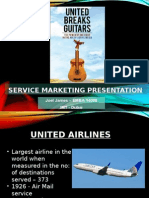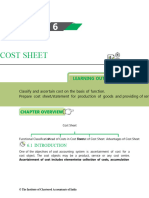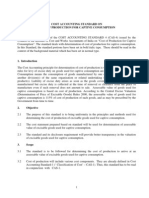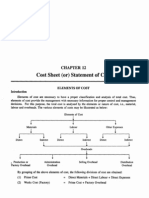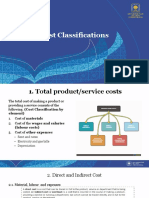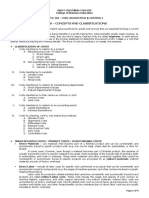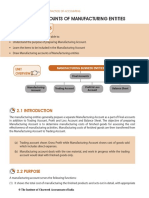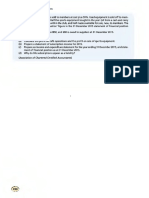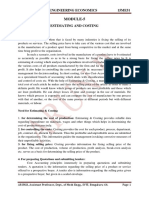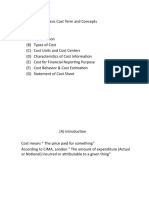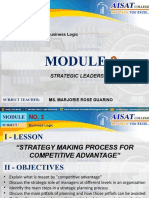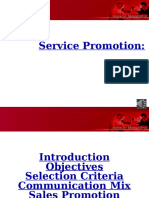74749bos60489 cp6
74749bos60489 cp6
Uploaded by
tempCopyright:
Available Formats
74749bos60489 cp6
74749bos60489 cp6
Uploaded by
tempOriginal Title
Copyright
Available Formats
Share this document
Did you find this document useful?
Is this content inappropriate?
Copyright:
Available Formats
74749bos60489 cp6
74749bos60489 cp6
Uploaded by
tempCopyright:
Available Formats
CHAPTER a
COST SHEET
LEARNING OUTCOMES
After studying this chapter, you would be able to-
Classify and ascertain Cost on the basis of function.
Prepare Cost Sheet/statement for production of goods and
providing of services.
CHAPTER OVERVIEW
Cost Sheet
Functional Head of Costs in Format of Cost Advantages of
Classification Cost Sheet Sheet Cost Sheet
1. INTRODUCTION
One of the objectives of cost accounting system is ascertainment of cost for a
cost object. The cost objects may be a product, service or any cost centre.
Ascertainment of cost includes elementwise collection of costs, accumulation
of the costs so collected for a certain volume or period and then arrange all
these accumulated costs into a sheet to calculate total cost for the cost
object. In this chapter, a product or a service will be the cost object for cost
calculation and cost ascertainment.
© The Institute of Chartered Accountants of India
a 6.2 COST AND MANAGEMENT ACCOUNTING
A Cost Sheet or Cost Statement is “a document which provides a detailed
cost information. In a typical cost sheet, cost information are presented on the
basis of functional classification. However, other classification may also be
adopted as per the requirements of users of the information.
2. FUNCTIONAL CLASSIFICATION OF ELEMENTS
OF COST
Under this classification, costs are divided according to the function for which
they have been incurred. The following are the classification of costs based on
functions:
(i) Direct Material Cost
(ii) Direct Employee (labour) Cost
(iii) Direct Expenses
(iv) Production/ Manufacturing Overheads
(v) Administration Overheads
(vi) Selling Overheads
(vii) Distribution Overheads
(viii) Research and Development costs etc.
3. COST HEADS IN A COST SHEET
The costs as classified on the basis of functions are grouped into the following
cost heads in a cost sheet:
(i) Prime Cost
(ii) Cost of Production
(iii) Cost of Goods Sold
(iv) Cost of Sales
© The Institute of Chartered Accountants of India
COST SHEET 6.3 a
3.1 Prime Cost
Prime cost represents the total of direct materials costs, direct employee
(labour) costs and direct expenses. The total of cost for each element has to be
calculated separately.
Direct Material Cost xxx
Direct Employees (labour) Cost xxx
Direct Expenses xxx
Prime Cost: xxxx
(i) Direct Material Cost: It is the cost of direct material consumed. The cost of
direct material consumed is calculated as follows:
Opening Stock of Material xxx
Add: Additions/ Purchases xxx
Less: Closing stock of Material (xxx)
Direct materials consumed xxxx
The valuation of materials purchased and issued for production shall be
done as per methods discussed in the ‘Chapter- 2 Material Cost’. Few
examples are:
(a) Cost of material;
(b) Freight inwards;
(c) Insurance and other expenditure directly attributable to
procurement;
(d) Trade discounts or rebates (to be deducted);
(e) Duties & Taxes (if input tax credit is not available/ availed) etc.
(ii) Direct Employee (Labour) Cost: It is the total of payment made to the
employees who are engaged in the production of goods and provision of
services. Employee cost is also known as labour cost; it includes the
following:
(a) Wages and salary;
© The Institute of Chartered Accountants of India
a 6.4 COST AND MANAGEMENT ACCOUNTING
(b) Allowances and incentives;
(c) Payment for overtimes;
(d) Bonus/ ex-gratia;
(e) Employer’s contribution to welfare funds such as Provident fund and
other similar funds;
(f) Other benefits (medical, leave with pay, free or subsidised food,
leave travel concession and provisions for retirement benefits) etc.
(iii) Direct Expenses: Expenses other than direct material cost and direct
employee cost, which are incurred to manufacture a product or for
provision of service and can be directly traced in an economically feasible
manner to a cost object. The following costs are examples for direct
expenses:
(a) Cost of utilities such as power & fuel, steam etc.;
(b) Royalty paid/ payable for production or provision of service;
(c) Hire charges paid for hiring specific equipment;
(d) Fee for technical assistance and know-how;
(e) Amortised cost of moulds, patterns, patents etc.;
(f) Cost for product/ service specific design or drawing;
(g) Cost of product/ service specific software;
(h) Other expenses which are directly related with the production of
goods or provision of service.
3.2 Cost of Production
In a conventional cost sheet, this item of cost can be seen. It is the total of
prime cost and factory related costs and overheads.
Prime Cost xxx
Add : Factory Overheads xxx
Gross Works Costs xxxx
Add: Opening stock of Work-in-process xxx
© The Institute of Chartered Accountants of India
COST SHEET 6.5 a
Less: Closing stock of Work-in-process (xxx)
Factory or Works Costs xxxx
Add: Quality Control Cost xxx
Add: Research & Development cost (Process related) xxx
Add: Administrative Overheads related with production xxx
Less: Credit for recoveries (miscellaneous income) (xxx)
Add: Packing Cost (Primary packing) xxx
Cost of Production xxxx
(i) Factory Overheads: It is also known as works/production/ manufacturing
overheads. It includes the following indirect costs:
(a) Consumable stores and spares;
(b) Depreciation of plant and machinery, factory building etc.
(c) Lease rent of production assets;
(d) Repair and maintenance of plant and machinery, factory building etc.
(e) Indirect employees cost related with production activities;
(f) Drawing and Designing department cost;
(g) Insurance of plant and machinery, factory building, stock of raw
material & WIP etc.
(h) Amortized cost of jigs, fixtures, tooling etc.
(i) Service department cost such as Tool Room, Engineering &
Maintenance, Pollution Control etc.
(ii) Stock of Work-in-process: The cost of opening and closing stock of work-
in-process (WIP) is adjusted to arrive at factory/ works cost. The WIP stock is
valued on the basis of percentage of completion in respect of each element
of cost. Students may refer the ‘Chapter- Process & Operation Costing’ to
know the WIP valuation methods.
(iii) Quality Control Cost: This is the cost of resources consumed towards
quality control procedures.
© The Institute of Chartered Accountants of India
a 6.6 COST AND MANAGEMENT ACCOUNTING
(iv) Research & Development Cost: It includes only those research and
development related cost which is incurred for the improvement of process,
system, product or services.
(v) Administrative Overheads: It includes only those administration overheads
which are related to production. The general administration overhead is
not included in production cost.
(vi) Credit for Recoveries: The realised or realisable value of scrap or waste is
deducted as it reduces the cost of production.
(vii) Packing Cost (primary): Packing material which is essential to hold and
preserve the product for its use by the customer.
(viii) Joint Products and By-Products: Joint costs are allocated between/among
the products on a rational and consistent basis. In case of by-products, the
net realisable value of by-products is deducted from the cost of production.
3.3 Cost of Goods Sold
It is the cost of production for goods sold. It is calculated after adjusting the
values of opening and closing stocks of finished goods. It can be calculated as below:
Cost of Production xxx
Add: Cost of Opening stock of finished goods xxx
Less: Cost of Closing stock of finished goods (xxx)
Cost of Goods Sold xxxx
3.4 Cost of Sales
It is the total cost of a product incurred to make the product available to the
customer or consumer. It includes Cost of goods sold, administration and
marketing expenses. It is calculated as below:
© The Institute of Chartered Accountants of India
COST SHEET 6.7 a
Cost of Goods Sold xxx
Add: Administrative Overheads (General) xxx
Add: Selling Overheads xxx
Add: Packing Cost (secondary) xxx
Add: Distribution Overheads xxx
Cost of Sales xxxx
(i) Administrative Overheads: It is the cost related with general
administration of the entity. It includes the followings:
(a) Depreciation and maintenance of, building, furniture etc. of corporate
or general management.
(b) Salary of administrative employees, accountants, directors, secretaries
etc.
(c) Rent, rates & taxes, insurance, lighting, office expenses etc.
(d) Indirect materials- printing and stationery, office supplies etc.
(e) Legal charges, audit fees, corporate office expenses like directors’
sitting fees, remuneration and commission, meeting expenses etc.
(ii) Selling Overheads: It is the cost related with sale of products or services.
It includes the following costs:
(a) Salary and wages related with sales department and employees
directly related with selling of goods.
(b) Rent, depreciation, maintenance and other cost related with sales
department.
(c) Cost of advertisement, maintenance of website for online sales,
market research etc.
(iii) Packing Cost (secondary): Packing material that enables to store,
transport, inform the customer, promote and otherwise make the product
marketable.
© The Institute of Chartered Accountants of India
a 6.8 COST AND MANAGEMENT ACCOUNTING
(iv) Distribution Overheads: It includes the cost related with making the
goods available to the customers. The costs are :
(a) Salary and wages of employees engaged in distribution of goods.
(b) Transportation and insurance costs related with distribution.
(c) Depreciation, hire charges, maintenance and other operating costs
related with distribution vehicles etc.
4. COST SHEET/STATEMENT
4.1 Presentation of Cost Information
The cost items in the cost statement shall be presented on ‘basis of relevant
classification’.
Specimen Format of Cost Sheet for a Manufacturing entity
Particulars Total Cost per
Cost (`) unit (`)
1. Direct materials consumed:
Opening Stock of Raw Material xxx
Add: Additions/ Purchases xxx
Less: Closing stock of Raw Material xxx
xxx
2. Direct employee (labour) cost xxx
3. Direct expenses xxx
4. Prime Cost (1+2+3) xxx
5. Add: Works/ Factory Overheads xxx
6. Gross Works Cost (4+5) xxx
7. Add: Opening Work in Process xxx
8. Less: Closing Work in Process (xxx)
9. Works/ Factory Cost (6+7-8) xxx
10. Add: Quality Control Cost xxx
11. Add: Research and Development Cost xxx
© The Institute of Chartered Accountants of India
COST SHEET 6.9 a
12. Add: Administrative Overheads (relating to xxx
production activity)
13. Less: Credit for Recoveries/Scrap/By-Products/ (xxx)
misc. income
14. Add: Packing cost (primary) xxx
15. Cost of Production (9+10+11+12-13+14) xxx
16. Add: Opening stock of finished goods xxx
17. Less: Closing stock of finished goods (xxx)
18. Cost of Goods Sold (15+16-17) xxx
19. Add: Administrative Overheads (General) xxx
20. Add: Marketing Overheads :
Selling Overheads xxx
Distribution Overheads xxx
21. Cost of Sales (18+19+20) xxx
Cost sheet/statement for services is also prepared but the format and
presentation may differ as per the information requirement. Format and
presentation has been discussed in “Service Costing” chapter.
4.2 Treatment of various items of Cost in Cost
Sheet/Statement
(i) Abnormal costs: Any abnormal cost, where it is material and quantifiable,
shall not form part of cost of production or acquisition or supply of goods
or provision of service. Examples of abnormal costs are:
(a) Cost pertaining to or arising out of a pandemic e.g. COVID-19
(b) Cost associated with employees due to sudden lockdown.
(ii) Subsidy/Grant/Incentives: Any such type of payment received/ receivable
are reduced from the cost objects to which such amount pertains.
(iii) Penalty, fine, damages, and demurrage: These types of expenses are not
form part of cost.
© The Institute of Chartered Accountants of India
a 6.10 COST AND MANAGEMENT ACCOUNTING
(iv) Interest and other finance costs: Interest, including any payment in the
nature of interest for use of non-equity funds and incidental cost that an
entity incurs in arranging those funds. Interest and finance charges are not
included in cost of production. Interest and Financing Charges shall be
presented in the cost statement as a separate item of cost of sales.
4.3 Advantages of Cost Sheet or Cost Statements
The main advantages of a Cost Sheet are as follows:
(i) It provides the total cost figure as well as cost per unit of production.
(ii) It helps in cost comparison.
(iii) It facilitates the preparation of cost estimates required for submitting
tenders.
(iv) It provides sufficient help in arriving at the figure of selling price.
(v) It facilitates cost control by disclosing operational efficiency.
ILLUSTRATION 1
The following data relates to the manufacture of a standard product during the
month of April:
Particulars (`)
Raw materials ` 1,80,000
Direct wages ` 90,000
Machine hours worked (hours) 10,000
Machine hour rate (per hour) `8
Administration overheads (general) ` 35,000
Selling overheads (per unit) `5
Units produced 4,000
Units sold 3,600
Selling price per unit ` 125
© The Institute of Chartered Accountants of India
COST SHEET 6.11 a
You are required to PREPARE a cost sheet in respect of the above showing:
(i) Cost per unit
(ii) Profit for the month
SOLUTION
(i) Cost Sheet Output: 4,000 units
Particulars Total Cost per
Cost (`) (unit) (`)
Raw materials 1,80,000 45.00
Direct wages 90,000 22.50
Prime cost 2,70,000 67.50
Add: Factory overheads (10,000 hrs × ` 8 per hour) 80,000 20.00
Cost of Production 3,50,000 87.50
Less: Closing Stock of finished goods (4,000 – (35,000) --
3,600 units)
Cost of Goods Sold 3,15,000 87.50
Add: Administration overheads (general) 35,000 9.72
Add: Selling Overheads (3,600 units × ` 5 unit) 18,000 5.00
Cost of sales (total Cost) 3,68,000 102.22
(ii) Statement of Profit
Particulars Total Cost (`)
Sales revenue (3,600 units @ ` 125) 4,50,000
Less: Cost of sales 3,68,000
Profit 82,000
© The Institute of Chartered Accountants of India
a 6.12 COST AND MANAGEMENT ACCOUNTING
ILLUSTRATION 2
The following information has been obtained from the records of ABC
Corporation for the period from June 1 to June 30.
On June 1 On June 30
(`) (`)
Cost of raw materials 60,000 50,000
Cost of work-in-process 12,000 15,000
Cost of stock of finished goods 90,000 1,10,000
Purchase of raw materials during June 2020 4,80,000
Wages paid 2,40,000
Factory overheads 1,00,000
Administration overheads (related to 50,000
production)
Selling & distribution overheads 25,000
Sales 10,00,000
PREPARE a statement giving the following information:
(a) Raw materials consumed;
(b) Prime cost;
(c) Factory cost;
(d) Cost of goods sold; and
(e) Net profit.
© The Institute of Chartered Accountants of India
COST SHEET 6.13 a
SOLUTION
Statement of Cost & Profit
(for the month of June)
(`)
Opening stock of raw materials 60,000
Add: Purchase of raw materials during the month of June 4,80,000
Less: Closing stock of raw materials (50,000)
(a) Raw materials consumed 4,90,000
Add: Direct wages 2,40,000
(b) Prime cost 7,30,000
Add: Factory overheads 1,00,000
Works cost 8,30,000
Add: Opening work-in-process 12,000
Less: Closing work-in-process (15,000)
(c) Factory cost 8,27,000
Add: Administration overheads 50,000
Cost of production 8,77,000
Add: Opening stock of finished goods 90,000
Less: Closing stock of finished goods (1,10,000)
(d) Cost of goods sold 8,57,000
Add: Selling & distribution overheads 25,000
Cost of sales 8,82,000
(e) Net Profit 1,18,000
Sales 10,00,000
© The Institute of Chartered Accountants of India
a 6.14 COST AND MANAGEMENT ACCOUNTING
ILLUSTRATION 3
Arnav Inspat Udyog Ltd. has the following expenditures for the year ended 31st
March 2023:
Sl. (` ) (` )
No.
(i) Raw materials purchased 10,00,00,000
(ii) GST paid on the above purchases @18% 1,80,00,000
(eligible for input tax credit)
(iii) Freight inwards 11,20,600
(iv) Wages paid to factory workers 29,20,000
(v) Contribution made towards employees’
PF & ESIS 3,60,000
(vi) Production bonus paid to factory workers 2,90,000
(vii) Royalty paid for production 1,72,600
(viii) Amount paid for power & fuel 4,62,000
(ix) Amount paid for purchase of moulds and
patterns (life is equivalent to two years
production) 8,96,000
(x) Job charges paid to job workers 8,12,000
(xi) Stores and spares consumed 1,12,000
(xii) Depreciation on:
Factory building 84,000
Office building 56,000
Plant & Machinery 1,26,000
Delivery vehicles 86,000 3,52,000
© The Institute of Chartered Accountants of India
COST SHEET 6.15 a
(xiii) Salary paid to supervisors 1,26,000
(xiv) Repairs & Maintenance paid for:
Plant & Machinery 48,000
Sales office building 18,000
Vehicles used by directors 19,600 85,600
(xv) Insurance premium paid for:
Plant & Machinery 31,200
Factory building 18,100
Stock of raw materials & WIP 36,000 85,300
(xvi) Expenses paid for quality control check
activities 19,600
(xvii) Salary paid to quality control staffs 96,200
(xviii) Research & development cost paid for
improvement in production process 18,200
(xix) Expenses paid for pollution control and
engineering & maintenance 26,600
(xx) Expenses paid for administration of
factory work 1,18,600
(xxi) Salary paid to functional mangers:
Production control 9,60,000
Finance & Accounts 9,18,000
Sales & Marketing 10,12,000 28,90,000
(xxii) Salary paid to General Manager 12,56,000
(xxiii) Packing cost paid for:
Primary packing necessary to maintain
quality 96,000
For re-distribution of finished goods 1,12,000 2,08,000
© The Institute of Chartered Accountants of India
a 6.16 COST AND MANAGEMENT ACCOUNTING
(xxiv) Interest and finance charges paid (for
usage of non- equity fund) 7,20,000
(xxv) Fee paid to auditors 1,80,000
(xxvi) Fee paid to legal advisors 1,20,000
(xxvii) Fee paid to independent directors 2,20,000
(xxviii) Performance bonus paid to sales staffs 1,80,000
(xxix) Value of stock as on 1st April, 2022:
Raw materials 18,00,000
Work-in-process 9,20,000
Finished goods 11,00,000 38,20,000
(xxx) Value of stock as on 31st March, 2023:
Raw materials 9,60,000
Work-in-process 8,70,000
Finished goods 18,00,000 36,30,000
Amount realized by selling of scrap and waste generated during manufacturing
process – ` 86,000/-
From the above data you are required to PREPARE Statement of cost for Arnav Ispat
Udyog Ltd. for the year ended 31st March, 2023, showing (i) Prime cost, (ii) Factory
cost, (iii) Cost of Production, (iv) Cost of goods sold and (v) Cost of sales.
SOLUTION
Statement of Cost of Arnav Ispat Udyog Ltd. for the year ended 31st March,
2023:
Sl. Particulars (`) (`)
No.
(i) Material Consumed:
Raw materials purchased 10,00,00,000
Freight inwards 11,20,600
Add: Opening stock of raw materials 18,00,000
Less: Closing stock of raw materials (9,60,000) 10,19,60,600
© The Institute of Chartered Accountants of India
COST SHEET 6.17 a
(ii) Direct employee (labour) cost:
Wages paid to factory workers 29,20,000
Contribution made towards employees’ PF
& ESIS 3,60,000
Production bonus paid to factory workers 2,90,000 35,70,000
(iii) Direct expenses:
Royalty paid for production 1,72,600
Amount paid for power & fuel 4,62,000
Amortised cost of moulds and patterns 4,48,000
Job charges paid to job workers 8,12,000 18,94,600
Prime Cost 10,74,25,200
(iv) Works/ Factory overheads:
Stores and spares consumed 1,12,000
Depreciation on factory building 84,000
Depreciation on plant & machinery 1,26,000
Repairs & Maintenance paid for plant &
machinery 48,000
Insurance premium paid for plant &
machinery 31,200
Insurance premium paid for factory
building 18,100
Insurance premium paid for stock of raw
materials & WIP 36,000
Salary paid to supervisors 1,26,000
Expenses paid for pollution control and
engineering & maintenance 26,600 6,07,900
Gross factory cost 10,80,33,100
Add: Opening value of W-I-P 9,20,000
Less: Closing value of W-I-P (8,70,000)
Factory Cost 10,80,83,100
© The Institute of Chartered Accountants of India
a 6.18 COST AND MANAGEMENT ACCOUNTING
(v) Quality control cost:
Expenses paid for quality control check
activities 19,600
Salary paid to quality control staffs 96,200 1,15,800
(vi) Research & development cost paid for
improvement in production process 18,200
(vii) Administration cost related with
production:
-Expenses paid for administration of
factory work 1,18,600
-Salary paid to Production control manager 9,60,000 10,78,600
(viii) Less: Realisable value on sale of scrap and
waste (86,000)
(ix) Add: Primary packing cost 96,000
Cost of Production 10,93,05,700
Add: Opening stock of finished goods 11,00,000
Less: Closing stock of finished goods (18,00,000)
Cost of Goods Sold 10,86,05,700
(x) Administrative overheads:
Depreciation on office building 56,000
Repairs & Maintenance paid for vehicles
used by directors 19,600
Salary paid to Manager- Finance &
Accounts 9,18,000
Salary paid to General Manager 12,56,000
Fee paid to auditors 1,80,000
Fee paid to legal advisors 1,20,000
Fee paid to independent directors 2,20,000 27,69,600
© The Institute of Chartered Accountants of India
COST SHEET 6.19 a
(xi) Selling overheads:
Repairs & Maintenance paid for sales office
building 18,000
Salary paid to Manager- Sales & Marketing 10,12,000
Performance bonus paid to sales staffs 1,80,000 12,10,000
(xii) Distribution overheads:
Depreciation on delivery vehicles 86,000
(xiii) Packing cost paid for re-distribution of
finished goods 1,12,000 1,98,000
(xiv) Interest and finance charges paid 7,20,000
Cost of Sales 11,35,03,300
Note:
GST paid on purchase of raw materials would not be part of cost of materials as it
is eligible for input tax credit.
SUMMARY
Cost Sheet: A Cost Sheet or Cost Statement is “a document which provides a
detailed cost information. In a typical cost sheet, cost information are
presented on the basis of functional classification. However, other classification
may also be adopted as per the requirements of users of the information.
Direct Expenses: Expenses other than direct material cost and direct
employee cost, which are incurred to manufacture a product or for
provision of service and can be directly traced in an economically feasible
manner to a cost object.
Prime Cost: Prime cost represents the total of direct materials costs, direct
employee (labour) costs and direct expenses.
Cost of Production: Cost of production consists of cost of materials
consumed, direct employee (labour) costs, direct expenses, production
overheads, quality control costs, primary packing cost, R&D and
administration cost relating to production.
© The Institute of Chartered Accountants of India
a 6.20 COST AND MANAGEMENT ACCOUNTING
Primary Packing Cost: Cost incurred on packing materials which are
essential to hold and preserve the product for further processing or its use
by consumer.
Secondary Packing Cost: Cost incurred on packing materials which is used
to store, transport, and promote the product.
Cost of Goods Sold: Cost of production adjusted with opening and closing
inventories of finished goods.
Administrative overheads: Cost incurred of all activities relating to general
management and administration of an entity.
Marketing overheads: Marketing overheads comprise of selling overheads
and distribution overheads.
Selling Overheads: Expenses related to sale of products or services.
Distribution overheads: Costs incurred in handling a product or service
from the time it is ready to dispatch or delivery until it reaches the ultimate
consumer.
Cost of Sales: It is the total cost of a product incurred to make the product
available to the customer or consumer. It is the aggregate of cost of goods
sold, administrative costs, marketing costs and other separate line items of
cost which could not form part of cost of production.
TEST YOUR KNOWLEDGE
Multiple Choice Questions (MCQs)
1. Generally, for the purpose of cost sheet preparation, costs are classified on the
basis of:
(a) Functions
(b) Variability
(c) Relevance
(d) Nature
© The Institute of Chartered Accountants of India
COST SHEET 6.21 a
2. Which of the following does not form part of prime cost:
(a) Cost of packing
(b) Cost of transportation paid to bring materials to factory
(c) GST paid on raw materials (input credit cannot be claimed)
(d) Overtime premium paid to workers.
3. A Ltd. received an order, for which it purchased a special frame for
manufacturing, it is a part of:
(a) Direct Materials
(b) Direct expenses
(c) Factory Overheads
(d) Administration Overheads
4. Salary paid to plant supervisor is a part of
(a) Direct expenses
(b) Factory overheads
(c) Quality control cost
(d) Administration cost
5. Depreciation of director’s laptop is treated as a part of:
(a) Administration Overheads
(b) Factory Overheads
(c) Direct Expenses
(d) Research & Development cost.
6. A manufacture has set-up a lab for testing of products for compliance with
standards, salary of this lab staffs are part of:
(a) Works overheads
(b) Quality Control Cost
(c) Direct Expenses
(d) Research & Development Cost.
© The Institute of Chartered Accountants of India
a 6.22 COST AND MANAGEMENT ACCOUNTING
7. Audit fees paid to auditors is part of:
(a) Administration Cost
(b) Production cost
(c) Selling & Distribution cost
(d) Not shown in cost sheet.
8. Salary paid to factory store staff is part of:
(a) Factory overheads
(b) Production Cost
(c) Direct Employee cost
(d) Direct Material Cost.
9. Canteen expenses for factory workers are part of:
(a) Factory overhead
(b) Administration Cost
(c) Marketing cost
(d) None of the above.
10. A company pays royalty to State Government on the basis of production, it is
treated as:
(a) Direct Material Cost
(b) Factory Overheads
(c) Direct Expenses
(d) Administration cost.
Theoretical Questions
1. DESCRIBE how costs are classified on the basis of function.
2. EXPLAIN the treatment of administration overheads.
3. STATE the advantages of a cost sheet.
© The Institute of Chartered Accountants of India
COST SHEET 6.23 a
Practical Problems
1. The books of Adarsh Manufacturing Company present the following data for
the month of April:
Direct labour cost ` 17,500 being 175% of works overheads.
Cost of goods sold excluding administrative expenses ` 56,000.
Inventory accounts showed the following opening and closing balances:
April 1 (`) April 30 (`)
Raw materials 8,000 10,600
Work-in-progress 10,500 14,500
Finished goods 17,600 19,000
Other data are:
(` )
Selling expenses 3,500
General and administration expenses 2,500
Sales for the month 75,000
You are required to:
(i) FIND out the value of materials purchased.
(ii) PREPARE a cost statement showing the various elements of cost and
also the profit earned.
2. From the following particulars, you are required to PREPARE monthly cost
sheet of Aditya Industries:
(` )
Opening Inventories:
- Raw materials 12,00,000
- Work-in-process 18,00,000
- Finished goods (10,000 units) 9,60,000
© The Institute of Chartered Accountants of India
a 6.24 COST AND MANAGEMENT ACCOUNTING
Closing Inventories:
- Raw materials 14,00,000
- Work-in-process 16,04,000
- Finished goods ?
Raw materials purchased 1,44,00,000
GST paid on raw materials purchased (ITC 7,20,000
available)
Wages paid to production workers 36,64,000
Expenses paid for utilities 1,45,600
Office and administration expenses paid 26,52,000
Travelling allowance paid to office staffs 1,21,000
Selling expenses 6,46,000
Machine hours worked- 21,600 hours
Machine hour rate- ` 8.00 per hour
Units sold- 1,60,000
Units produced- 1,94,000
Desired profit- 15% on sales
3. A Ltd. Co. has capacity to produce 1,00,000 units of a product every month. Its
works cost at varying levels of production is as under:
Level Works cost per unit ( `)
10% 400
20% 390
30% 380
40% 370
50% 360
60% 350
70% 340
80% 330
90% 320
100% 310
© The Institute of Chartered Accountants of India
COST SHEET 6.25 a
Its fixed administration expenses amount to `1,50,000 and fixed marketing
expenses amount to `2,50,000 per month respectively. The variable
distribution cost amounts to ` 30 per unit.
It can sell 100% of its output at `500 per unit provided it incurs the following
further expenditure:
(a) it gives gift items costing ` 30 per unit of sale;
(b) it has lucky draws every month giving the first prize of ` 50,000; 2nd
prize of ` 25,000, 3rd prize of ` 10,000 and three consolation prizes of `
5,000 each to customers buying the product.
(c) it spends `1,00,000 on refreshments served every month to its
customers;
(d) it sponsors a television programme every week at a cost of ` 20,00,000
per month.
It can market 30% of its output at `550 per unit without incurring any of the
expenses referred to in (a) to (d) above.
PREPARE a cost sheet for the month showing total cost and profit at 30% and
100% capacity level.
4. The following figures are extracted from the Trial Balance of G.K Co. on 31 st
March:
Dr. Cr.
(`) (`)
Inventories:
Finished Stock 80,000
Raw Materials 1,40,000
Work-in-Process 2,00,000
Office Appliances 17,400
Plant & Machinery 4,60,500
Building 2,00,000
© The Institute of Chartered Accountants of India
a 6.26 COST AND MANAGEMENT ACCOUNTING
Sales 7,68,000
Sales Return and Rebates 14,000
Materials Purchased 3,20,000
Freight incurred on Materials 16,000
Purchase Returns 4,800
Direct employee cost 1,60,000
Indirect employee cost 18,000
Factory Supervision 10,000
Repairs and factory up-keeping expenses 14,000
Heat, Light and Power 65,000
Rates and Taxes 6,300
Miscellaneous Factory Expenses 18,700
Sales Commission 33,600
Sales Travelling 11,000
Sales Promotion 22,500
Distribution Deptt.—Salaries and Expenses 18,000
Office Salaries and Expenses 8,600
Interest on Borrowed Funds 2,000
Further details are available as follows:
(i) Closing Inventories:
Finished Goods 1,15,000
Raw Materials 1,80,000
Work-in-Process 1,92,000
(ii) Outstanding expenses on:
Direct employee cost 8,000
Indirect employee cost 1,200
Interest on Borrowed Funds 2,000
© The Institute of Chartered Accountants of India
COST SHEET 6.27 a
(iii) Depreciation to be provided on:
Office Appliances 5%
Plant and Machinery 10%
Buildings 4%
(iv) Distribution of the following costs:
Heat, Light and Power to Factory, Office and Distribution in the ratio
8 : 1 : 1.
Rates and Taxes two-thirds to Factory and one-third to Office.
Depreciation on Buildings to Factory, Office and Selling in the ratio
8 : 1 : 1.
With the help of the above information, you are required to PREPARE a
condensed Profit and Loss Statement of G.K Co. for the year ended 31 st March
along with supporting schedules of:
(i) Cost of Sales.
(ii) Selling and Distribution Expenses.
(iii) Administration Expenses
ANSWERS
Answers to the MCQs
1. (a) 2. (a) 3. (b) 4. (b) 5. (a) 6. (b)
7. (a) 8. (a) 9. (a) 10. (c)
Answers to the Theoretical Questions
1. Please refer paragraph 2
2. Please refer paragraph 3.4
3. Please refer paragraph 4.3
© The Institute of Chartered Accountants of India
a 6.28 COST AND MANAGEMENT ACCOUNTING
Answers to the Practical Problems
1. (i) Computation of the value of materials purchased
To find out the value of materials purchased, reverse calculations from
the given data can be presented as below:
Particulars (`)
Cost of goods sold 56,000
Add: Closing stock of finished goods 19,000
Less: Opening stock of finished goods (17,600)
Cost of production 57,400
Add: Closing stock of work-in-progress 14,500
Less: Opening stock of work-in-progress (10,500)
Works cost 61,400
`17,500 100 (10,000)
Less: Factory overheads:
175
Prime cost 51,400
Less: Direct labour (17,500)
Raw material consumed 33,900
Add: Closing stock of raw materials 10,600
Raw materials available 44,500
Less: Opening stock of raw materials ( 8,000)
Value of materials purchased 36,500
© The Institute of Chartered Accountants of India
COST SHEET 6.29 a
(ii) Cost statement
(`)
Raw material consumed [Refer to statement (i) above] 33,900
Add: Direct labour cost 17,500
Prime cost 51,400
Add: Factory overheads 10,000
Works cost 61,400
Add: Opening work-in-progress 10,500
Less: Closing work-in-progress (14,500)
Cost of production 57,400
Add: Opening stock of finished goods 17,600
Less: Closing stock of finished goods (19,000)
Cost of goods sold 56,000
Add: General and administration expenses 2,500
Add: Selling expenses 3,500
Cost of sales 62,000
Profit (Balance figure ` 75,000 – ` 62,000) 13,000
Sales 75,000
2. Cost sheet of Aditya Industries for month of……
Units produced- 1,94,000
Units sold- 1,60,000
Particulars (`) Cost per unit (`)
Raw materials purchased 1,44,00,000
Add: Opening value of raw materials 12,00,000
Less: Closing value of raw materials (14,00,000)
Materials consumed 1,42,00,000 73.19
© The Institute of Chartered Accountants of India
a 6.30 COST AND MANAGEMENT ACCOUNTING
Wages paid to production workers 36,64,000 18.89
Expenses paid for utilities 1,45,600 0.75
Prime Cost 1,80,09,600 92.83
Factory overheads (` 8 × 21,600 hours) 1,72,800
Add: Opening value of W-I-P 18,00,000
Less: Closing value of W-I-P (16,04,000)
Cost of Production 1,83,78,400 94.73
Add: Value of opening finished stock 9,60,000
Less: Value of closing finished stock (` (41,68,120)
94.73 × 44,000)
Cost of Goods Sold 1,51,70,280 94.81
Office and administration expenses 26,52,000 16.58
paid
Travelling allowance paid to office 1,21,000 0.75
staffs
Selling expenses 6,46,000 4.04
Cost of Sales 1,85,89,280 116.18
Add: Profit 32,80,461 20.50
2,18,69,741 136.68
3. Cost Sheet (For the month)
Level of Capacity 30% 100%
30,000 units 1,00,000 units
Per Total Per Total
unit (`) unit (`)
(`) (`)
Works Cost 380.00 1,14,00,000 310.00 3,10,00,000
Add: Fixed 5.00 1,50,000 1.50 1,50,000
administration
expenses
© The Institute of Chartered Accountants of India
COST SHEET 6.31 a
Add: Fixed marketing 8.33 2,50,000 2.50 2,50,000
expenses
Add: Variable 30.00 9,00,000 30.00 30,00,000
distribution
cost
Add: Special Costs:
- Gift items costs — — 30.00 30,00,000
- Customers’ prizes* — — 1.00 1,00,000
- Refreshments — — 1.00 1,00,000
- Television
programme — — 20.00 20,00,000
sponsorship cost
Cost of sales 423.33 1,27,00,000 396.00 3,96,00,000
Profit (Balancing figure) 126.67 38,00,000 104.00 1,04,00,000
Sales revenue 550.00 1,65,00,000 500.00 5,00,00,000
*Customers’ prize cost:
Amount (`)
1 Prize
st
50,000
2 nd
Prize 25,000
3 Prize
rd
10,000
Consolation Prizes (3 × `5,000) 15,000
Total 1,00,000
4. Profit and Loss Statement of G.K Co.
for the year ended 31st March
(`) (`)
Gross Sales 7,68,000
Less: Returns and rebates (14,000) 7,54,000
Less: Cost of Sales [Refer to Schedule (i)] (7,14,020)
Net Operating Profit 39,980
Less: Interest on borrowed funds (4,000)
(2,000+2,000)
Net Profit 35,980
© The Institute of Chartered Accountants of India
a 6.32 COST AND MANAGEMENT ACCOUNTING
(i) Schedule of Cost of Sales
(`) (`)
Raw Material (Inventory opening balance) 1,40,000
Add: Material Purchased 3,20,000
Add: Freight on Material 16,000
Less: Purchase Returns (4,800) 3,31,200
4,71,200
Less: Closing Raw Material Inventory (1,80,000)
Materials consumed in Production 2,91,200
Direct employee cost (`1,60,000 + `8,000) 1,68,000
Prime Cost 4,59,200
Factory Overheads:
Indirect employee cost (`18,000 + `1,200) 19,200
Factory Supervision 10,000
Repairs and factory up-keeping expenses 14,000
Heat, Light and Power (`65,000 × 8/10) 52,000
Rates and Taxes (`6,300 × 2/3 rd) 4,200
Miscellaneous Factory Expenses 18,700
Depreciation of Plant (10% of `4,60,500) 46,050
Depreciation of Buildings (4% of `2,00,000 × 6,400 1,70,550
8/10)
Gross Works Cost 6,29,750
Add: Opening Work-in-Process inventory 2,00,000
Less: Closing Work-in-Process inventory (1,92,000)
Cost of production 6,37,750
© The Institute of Chartered Accountants of India
COST SHEET 6.33 a
Add: Opening Finished Goods inventory 80,000
Less: Closing Finished Goods inventory (1,15,000)
Cost of Goods Sold 6,02,750
Add: Administration Expenses [See 18,870
Schedule (iii)]
Add: Selling and Distribution Expenses 92,400
[See Schedule (ii)]
Cost of Sales 7,14,020
(ii) Schedule of Selling and Distribution Expenses
(`)
Sales Commission 33,600
Sales Travelling 11,000
Sales Promotion 22,500
Distribution Deptt.—Salaries and Expenses 18,000
Heat, Light and Power 6,500
Depreciation of Buildings 800
92,400
(iii) Schedule of Administration Expenses
(`)
Office Salaries and Expenses 8,600
Depreciation of Office Appliances 870
Depreciation of Buildings 800
Heat, Light and Power 6,500
Rates and Taxes 2,100
18,870
© The Institute of Chartered Accountants of India
© The Institute of Chartered Accountants of India
You might also like
- Feasibility StudyDocument56 pagesFeasibility StudyLilibeth Amparo100% (5)
- Service Marketing Presentation - Untied Breaks GuitarsDocument18 pagesService Marketing Presentation - Untied Breaks GuitarsdreamagiczNo ratings yet
- Amorim GroupDocument52 pagesAmorim GrouparamszaginianNo ratings yet
- 82135bos66210 cp6Document37 pages82135bos66210 cp60fficiialakayNo ratings yet
- Cost SheetDocument26 pagesCost SheetPankaj SahaniNo ratings yet
- Cost SheetDocument26 pagesCost Sheetvenkatkamineni01No ratings yet
- Cost SheetDocument19 pagesCost SheetpraphullmadaneNo ratings yet
- Cost Sheet: Learning OutcomesDocument15 pagesCost Sheet: Learning OutcomesshubNo ratings yet
- Cost SheetDocument5 pagesCost SheetAnkit YadavNo ratings yet
- COST ACCOUNTING I Module VDocument4 pagesCOST ACCOUNTING I Module VEmil E. ANo ratings yet
- 103 Sample ChapterDocument28 pages103 Sample ChapterRithik VisuNo ratings yet
- 103 Sample Chapter PDFDocument28 pages103 Sample Chapter PDFKomal MusaleNo ratings yet
- CHP 6. Cost Sheet - CapranavDocument14 pagesCHP 6. Cost Sheet - CapranavMonikaNo ratings yet
- CAS 4-Cost of Prod. For Captive ConsumptionDocument8 pagesCAS 4-Cost of Prod. For Captive ConsumptionVivekanandNo ratings yet
- Cost Sheet SummaryDocument8 pagesCost Sheet SummaryBahi Khata CommerceNo ratings yet
- Introduction To Cost AccountingDocument39 pagesIntroduction To Cost AccountingZeeshan AliNo ratings yet
- Chapter 12 Cost Sheet or Statement of CostDocument16 pagesChapter 12 Cost Sheet or Statement of CostNeelesh MishraNo ratings yet
- Fundamentals of Cost Its Elements and ClassificationDocument8 pagesFundamentals of Cost Its Elements and ClassificationRyan intoNo ratings yet
- Cost SheetDocument5 pagesCost Sheetgaurav gauravNo ratings yet
- Chapter SixDocument11 pagesChapter SixhussenNo ratings yet
- Cost ClassifictionsDocument15 pagesCost Classifictionsnassif aljbooryNo ratings yet
- RR Cost SheetDocument4 pagesRR Cost SheetRamiz SiddiquiNo ratings yet
- Course Title: Cost Accounting Course Code:441 BBA Program Lecture-2Document14 pagesCourse Title: Cost Accounting Course Code:441 BBA Program Lecture-2Tanvir Ahmed ChowdhuryNo ratings yet
- A.3. Cost ClassificationsDocument57 pagesA.3. Cost ClassificationsTiyas KurniaNo ratings yet
- PPC unit IIDocument73 pagesPPC unit IIgk732011No ratings yet
- Chap 4 (Activity based costing)Document5 pagesChap 4 (Activity based costing)M Zaryab Ali ShahNo ratings yet
- Chapter 06 Statement of Cost SheetDocument16 pagesChapter 06 Statement of Cost SheetkausarNo ratings yet
- Chapter 2 Hilton 10th Instructor NotesDocument10 pagesChapter 2 Hilton 10th Instructor NotesKD MV100% (2)
- CAS 22 Manufacturing CostDocument12 pagesCAS 22 Manufacturing CostPawan KumarNo ratings yet
- Introduction To Cost Accounting: MeaningDocument11 pagesIntroduction To Cost Accounting: MeaningTejas YeoleNo ratings yet
- Costs - Concepts and ClassificationsDocument5 pagesCosts - Concepts and ClassificationsCarlo B CagampangNo ratings yet
- Cost Classification For Inventory Valuation and ProfitDocument4 pagesCost Classification For Inventory Valuation and ProfitRao EhsanNo ratings yet
- Dr. Prabhu Dayal Saini PDFDocument13 pagesDr. Prabhu Dayal Saini PDFRavi ModiNo ratings yet
- Cost Sheet: Definition, Elements of Cost and CalculationsDocument22 pagesCost Sheet: Definition, Elements of Cost and CalculationsOmkar JadhavNo ratings yet
- COST Lesson 2Document4 pagesCOST Lesson 2Christian Clyde Zacal Ching0% (1)
- Product Costing Chap 1&2Document19 pagesProduct Costing Chap 1&2Tes KingNo ratings yet
- Cost Sheet NotesDocument15 pagesCost Sheet NotesPratiksha SardaNo ratings yet
- Unit 2: Final Accounts of Manufacturing Entities: Learning OutcomesDocument17 pagesUnit 2: Final Accounts of Manufacturing Entities: Learning OutcomessajedulNo ratings yet
- Manufacturing AccountsDocument19 pagesManufacturing AccountsUzair Razin Bin AhamedNo ratings yet
- Chapter 4.2 - Basic Cost ConceptsDocument19 pagesChapter 4.2 - Basic Cost ConceptsMehta Vani JogheeNo ratings yet
- ME Module 5Document12 pagesME Module 5Pratham J TudoorNo ratings yet
- Unit Five: Accounting For Factory Over Head Costs ContentDocument30 pagesUnit Five: Accounting For Factory Over Head Costs Contentዝምታ ተሻለNo ratings yet
- 1 Introduction To Cost Accounting (2017)Document62 pages1 Introduction To Cost Accounting (2017)kilogek124No ratings yet
- Overheads - Absorption Costing Method: Learning OutcomesDocument89 pagesOverheads - Absorption Costing Method: Learning Outcomessamyak bafnaNo ratings yet
- Manufacturing ManagementDocument126 pagesManufacturing ManagementSIDDHARTH JHANo ratings yet
- Sabou Felicia 2Document5 pagesSabou Felicia 2k61.2212340032No ratings yet
- Absorption CostDocument2 pagesAbsorption CostXtreme FunNo ratings yet
- 110-W2-3-Cost concept-chp02-STDocument85 pages110-W2-3-Cost concept-chp02-STmargaret mariaNo ratings yet
- Pillai College of Arts, Commerce and Science, New Panvel: (Autonomous)Document9 pagesPillai College of Arts, Commerce and Science, New Panvel: (Autonomous)DivyanshiNo ratings yet
- Chapter 5 Cost and Management AcctDocument35 pagesChapter 5 Cost and Management AcctDebebe DanielNo ratings yet
- GroupDocument173 pagesGroupvivek1929No ratings yet
- CH 02 SMDocument14 pagesCH 02 SMapi-267019092No ratings yet
- Unit - 2 Final Accounts of Manufacturing Entities: Learning OutcomesDocument17 pagesUnit - 2 Final Accounts of Manufacturing Entities: Learning OutcomesNeha GoelNo ratings yet
- Cost and Management Accounting I Chapter 3Document58 pagesCost and Management Accounting I Chapter 3Girma NageoNo ratings yet
- Basic Cost Term and Concepts - An Inrodution 13.12.22Document36 pagesBasic Cost Term and Concepts - An Inrodution 13.12.22JayaNo ratings yet
- Cost SheetDocument17 pagesCost Sheet9986212378No ratings yet
- Chapter 11 Cost Methods Techniques of Cost Accounting and Classification of Cost1 PDFDocument5 pagesChapter 11 Cost Methods Techniques of Cost Accounting and Classification of Cost1 PDFdipunene100% (1)
- Manufacturing AccountsDocument10 pagesManufacturing Accountsamosoundo59No ratings yet
- Manufacturing Wastes Stream: Toyota Production System Lean Principles and ValuesFrom EverandManufacturing Wastes Stream: Toyota Production System Lean Principles and ValuesRating: 4.5 out of 5 stars4.5/5 (3)
- Strategic Leadership: Business LogicDocument14 pagesStrategic Leadership: Business LogicMarjorie Rose GuarinoNo ratings yet
- CEI - Corporate PresentationDocument25 pagesCEI - Corporate PresentationKrsto ZlatkovNo ratings yet
- Procurement Cover Letter TemplateDocument5 pagesProcurement Cover Letter Templateebqlsqekg100% (1)
- Marketing DarazDocument46 pagesMarketing Darazalisalman1No ratings yet
- Principles of Managerial FinanceDocument37 pagesPrinciples of Managerial FinanceAngela VeronikaNo ratings yet
- Event Management ChecklistDocument14 pagesEvent Management ChecklistBilal ShahNo ratings yet
- Opn Policy DocumentDocument6 pagesOpn Policy DocumentMohammad AkramNo ratings yet
- Herbalife Reborn: Business EthicsDocument16 pagesHerbalife Reborn: Business EthicsShaheenNo ratings yet
- Two Marks Question and AnswersDocument71 pagesTwo Marks Question and AnswersBoopathy KarthikeyanNo ratings yet
- Sample Budget Golf TournamentDocument2 pagesSample Budget Golf TournamentAzlan Shah Ahmad ShahNo ratings yet
- 3.4 Promotion - Communication Mix - Ankit SharmaDocument28 pages3.4 Promotion - Communication Mix - Ankit SharmaAnkit SharmaNo ratings yet
- Business To Consumer DisbursementsDocument17 pagesBusiness To Consumer Disbursementsstang12290No ratings yet
- Chapter 14Document12 pagesChapter 14Denis LordanNo ratings yet
- Module 2Document13 pagesModule 2A Kaur MarwahNo ratings yet
- Drucker GlossaryDocument3 pagesDrucker Glossaryapi-370088506No ratings yet
- Company Profile (Sos)Document11 pagesCompany Profile (Sos)hukkerisourabh4569No ratings yet
- The Lynchburg Times: September 9 - 15, 2010Document24 pagesThe Lynchburg Times: September 9 - 15, 2010Dan McDermottNo ratings yet
- Creating A Marketing PlanDocument5 pagesCreating A Marketing PlanjhanelNo ratings yet
- Marketing Management Unit 1Document14 pagesMarketing Management Unit 1Siva RatheeshNo ratings yet
- CRM vs. MKISDocument20 pagesCRM vs. MKISStani Jude JohnNo ratings yet
- Marketing, Introduction Chapter 1 Rosalind Masterson & David PicktonDocument36 pagesMarketing, Introduction Chapter 1 Rosalind Masterson & David Picktonsantito120380% (10)
- Strategic FormulationDocument29 pagesStrategic FormulationAfreen KhanNo ratings yet
- SHANGRILADocument7 pagesSHANGRILANavya RayiNo ratings yet
- Modern Trends in Marketing Management-A Review: Mr. Hargude N. V, Miss. Raut Nutan Dattatray, Mr. A. R. DandekarDocument5 pagesModern Trends in Marketing Management-A Review: Mr. Hargude N. V, Miss. Raut Nutan Dattatray, Mr. A. R. DandekarTobalyntiNo ratings yet
- Pricing Strategy To The Product Life Cycle StageDocument9 pagesPricing Strategy To The Product Life Cycle StageAva DasNo ratings yet
- What Is A Competitive Profile Matrix (CPM) ?Document3 pagesWhat Is A Competitive Profile Matrix (CPM) ?Katrizia FauniNo ratings yet
- Rai BornDocument210 pagesRai BornJuliet Galupe AntimorNo ratings yet

